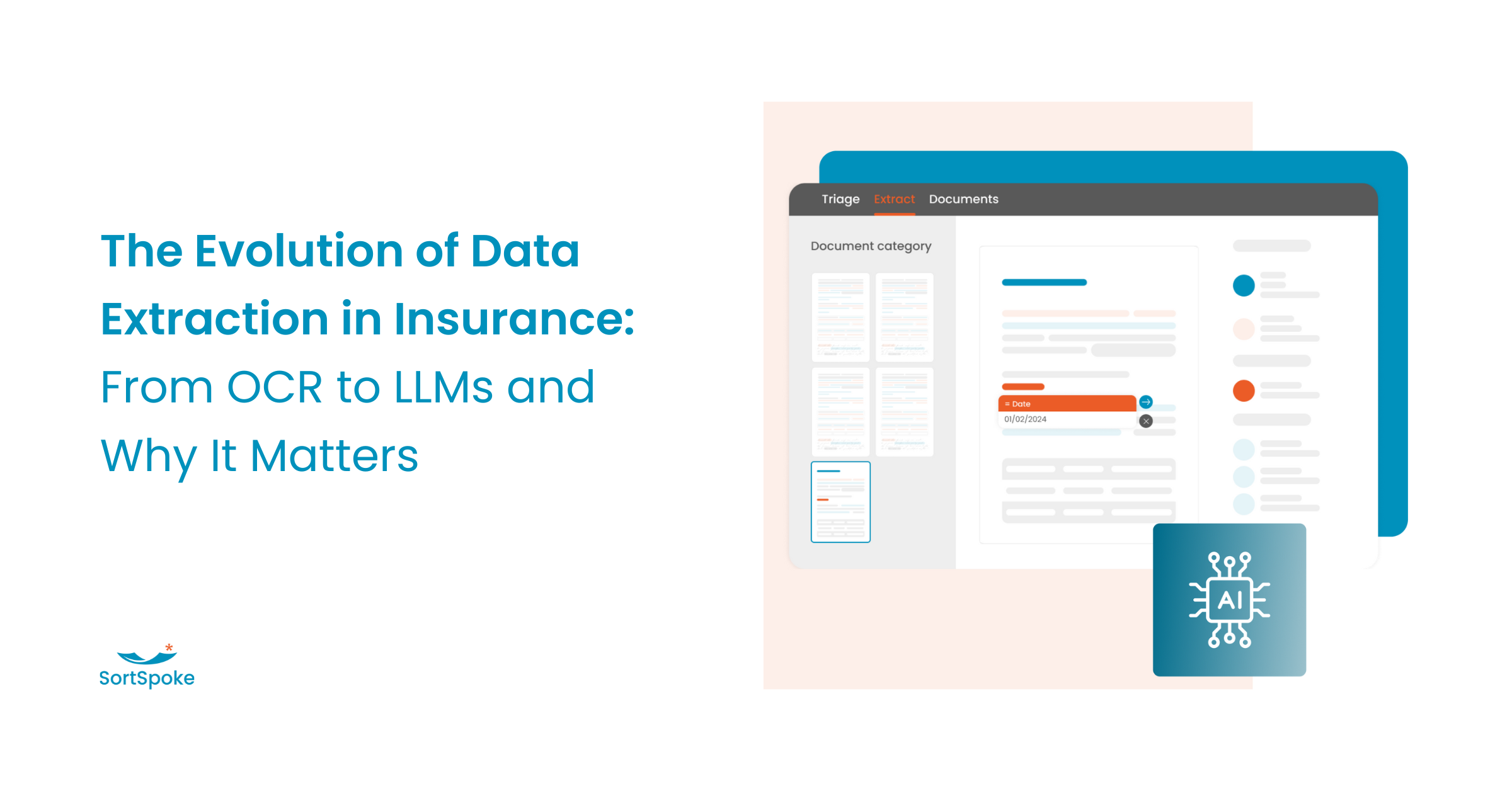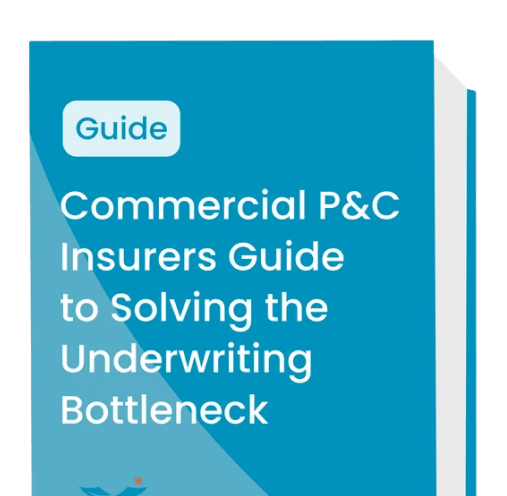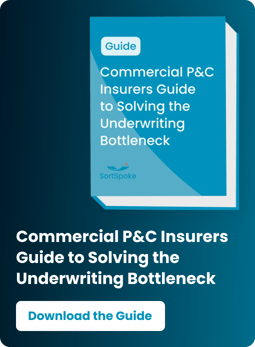
Evolution of Data Extraction: From OCR to IDP to LLM (and why it matters)
TL;DR
- OCR was just the beginning – useful for digitizing text but couldn't understand context or handle complex insurance documents
- IDP improved extraction with machine learning but still relied on templates and black-box models that offered little flexibility
- LLMs represent a breakthrough – they understand context, handle any document format, but require oversight from underwriters in real time
- SortSpoke combines LLMs with human expertise – enabling underwriters to process 5X more submissions while maintaining full control and auditability
- The future is about augmentation, not replacement – AI handles extraction while underwriters focus on decision-making and teaching the system
Picture this: You're an underwriter in 1995, manually typing data from paper applications into your system. Fast-forward to today, and AI can read, understand, and extract that same data in seconds. But the journey from then to now wasn't a single leap—it was an evolution through three distinct generations of technology.
Understanding this evolution isn't just about appreciating how far we've come. It's about recognizing where we're headed and why the latest advances in AI-powered document processing represent a fundamental shift in how underwriting teams can work.
Let's trace this journey from the early days of OCR through today's sophisticated LLM-powered solutions, and explore why this matters for every insurance professional dealing with document-heavy workflows.
OCR: The First Step Toward Automation
For decades, Optical Character Recognition (OCR) was the insurance industry's go-to solution for digitizing paper documents. It solved a real problem: converting scanned text into machine-readable content meant no more manual typing of every single field from applications, loss runs, and certificates.
OCR was revolutionary for its time, but it had significant limitations that became apparent as insurance workflows grew more complex:
Key limitations of traditional OCR:
- No understanding of context or meaning – OCR could read the word "fire" but couldn't distinguish between "fire damage" and "fire department response"
- Struggled with messy, unstructured submissions – Real-world documents rarely matched the clean, standardized formats OCR worked best with
- Required extensive post-processing – Teams spent considerable time cleaning up and validating OCR output before it could be used
OCR was a helpful first step, but it wasn't designed to handle the nuanced, variable formats found in insurance documents. It could digitize text, but it couldn't truly understand what that text meant in context.
IDP: Smarter Extraction With Machine Learning
Intelligent Document Processing (IDP) emerged as the next evolution, building on OCR's foundation by adding machine learning capabilities. IDP systems could identify specific fields, understand document layouts, and extract data with more precision than basic OCR.
Where IDP improved things:
- Used rules and ML models to extract specific data points from known fields
- Reduced manual review for standardized forms and common document types
- Enabled limited learning from historical examples and training data
- Better handling of semi-structured documents like ACORD forms and standardized applications
IDP represented a significant improvement over basic OCR, especially for high-volume processing of standardized documents. Insurance companies could automate much of their data entry for routine submissions.
But important challenges remained:
- Template dependency – Most IDP systems still struggled when documents didn't match predetermined templates
- Black-box models – Many IDP solutions offered little insight into how extraction decisions were made
- Limited adaptability – When document formats changed or new submission types appeared, systems required IT intervention to retrain models
- Exception handling bottlenecks – Underwriters still faced significant manual work when documents fell outside system parameters
IDP moved the industry forward, but it still left underwriters doing too much exception handling and dealing with systems that couldn't adapt to the real-world variability of insurance documents.
LLMs: Real Understanding for Real-World Documents
The latest leap forward comes from Large Language Models (LLMs)—advanced AI that can understand and extract meaning from text the way a human would. This isn't just about better data extraction; it's about AI that truly comprehends context, relationships, and nuance.
What LLMs bring to insurance document processing:
Context-Aware Understanding
LLMs can read a submission and understand that "the building constructed in 1985 with updates in 2010" means the structure has both original and renovation dates, automatically extracting both pieces of information correctly.
Format Flexibility
Unlike template-based systems, LLMs can handle documents in any format—from formal ACORD applications to informal broker emails with attached spreadsheets.
Industry-Specific Intelligence
Modern LLMs can be trained on insurance-specific language and concepts, understanding terms like "occurrence basis," "aggregate limits," and "named insured" in their proper context.
LLM + ML Required Human Oversight
Even the smartest AI needs supervision. When underwriters review and correct extractions, that feedback is applied instantly via traditional machine learning, ensuring future documents are handled with greater precision. However, trusting an LLM to perform extraction alone is not advisable due to the risks of hallucinations.
A framework where AI handles initial processing and extraction, but human experts review, validate, and refine the results. The AI learns from these human interactions, continuously improving its performance while maintaining human oversight and control.
SortSpoke's Approach: LLMs + Human-in-the-Loop
At SortSpoke, we've built our platform around the principle that the most powerful AI is AI that works with underwriters, not instead of them. Our approach combines insurance-specific LLMs with a human-in-the-loop framework that delivers both speed and accuracy.
How SortSpoke's implementation works:
- AI-powered initial extraction – Our LLM reads and extracts data from any submission format
- Intelligent highlighting – The system shows exactly where each piece of data was found, making validation quick and easy
- One-click corrections – Underwriters can correct any mistakes with a single click
- Real-time learning – The system immediately learns from corrections and applies that knowledge to future similar documents
- Full auditability – Every extraction is fully traceable, meeting compliance requirements
The result? Underwriters can process 5X more submissions while maintaining complete control over data quality and accuracy.
Why This Evolution Matters: A Comparison
| Capability | OCR | IDP | LLM + Human-in-the-Loop (SortSpoke) |
|---|---|---|---|
| Format Flexibility | Structured documents only | Structured & semi-structured | Any format, including unstructured |
| Context Understanding | None | Limited rule-based logic | Deep contextual understanding |
| Template Dependence | High | Medium (rules/templates) | None required |
| Real-Time Learning | None | Static ML models | Continuous learning via human feedback |
| Auditability | Manual traceability | Black-box for many models | Fully traceable and auditable |
| Underwriter Role | Manual clean-up | Review exceptions | Review + teach AI as part of normal workflow |
The Future of Document Processing Is Here
The evolution from OCR to LLMs represents more than just incremental improvement—it's a fundamental shift in how AI can support underwriting workflows. With modern LLM-powered solutions like SortSpoke, insurance teams no longer have to choose between speed and accuracy.
Key advantages of the LLM + HITL approach:
- No setup required – Start processing documents immediately without creating templates or rules
- Handles complexity – Process everything from standard ACORD forms to broker emails and custom spreadsheets
- Learns continuously – Gets smarter with every submission as underwriters provide feedback
- Maintains control – Underwriters stay in charge of all final decisions while AI handles the heavy lifting
- Full transparency – Every extraction is explainable and auditable for compliance







